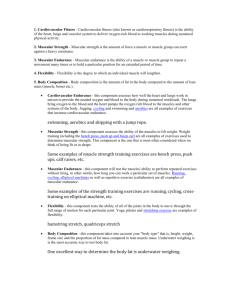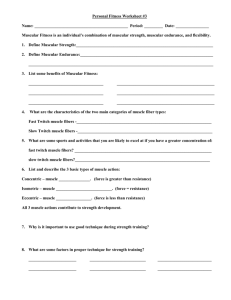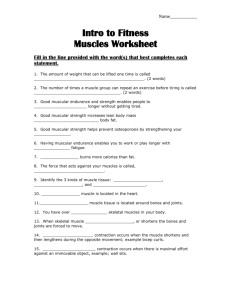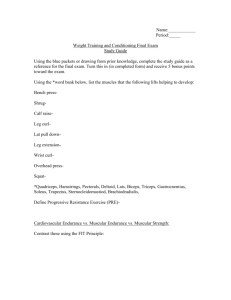Quiz II
advertisement
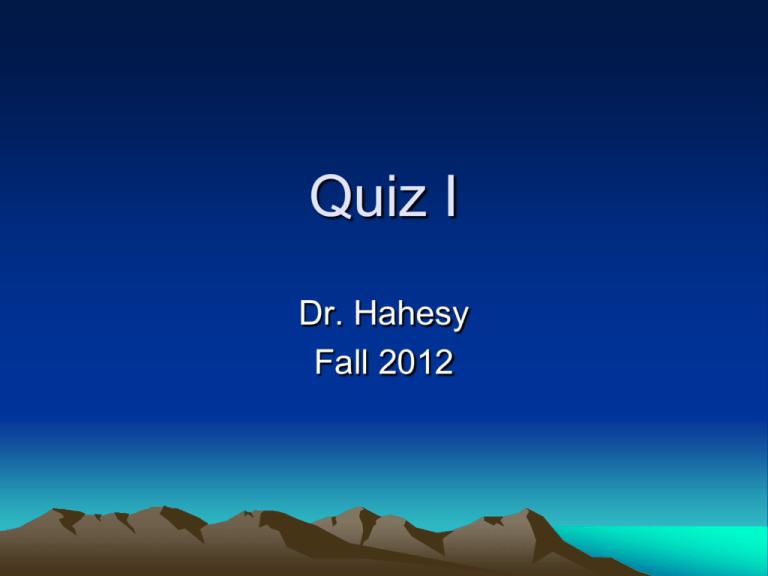
Quiz I Dr. Hahesy Fall 2012 Muscular Strength and Endurance • Muscular strength is the amount of force a muscle can produce with a single maximum effort – Muscular strength is usually assessed by measuring the maximum amount of weight a person can lift one time (1 RM) • Muscular endurance is the ability to resist fatigue while holding or repeating a muscular contraction – Muscular endurance assessed by counting the maximum number of repetitions of a muscular contraction a person can perform to fatigue • Well-developed muscles can assist with: • Daily routines • Protection from injury • Enhancement of your overall well-being Basic Muscle Physiology • Muscles consist of individual muscle fibers (cells) connected in bundles • Muscle fibers are made up of smaller protein structures called myofibrils • Proper strength training causes individual fibers to increase the number of myofibrils, resulting in hypertrophy • Inactivity can reverse this process, resulting in atrophy Skeletal Muscle Tissue Slow and Fast Twitch Muscle Fibers • Slow-twitch fibers are: • Fatigue resistant • Don’t contract as rapidly and forcefully as fast-twitch fibers • Rely primarily on the aerobic energy system • Fast-twitch fibers: • Contract rapidly and forcefully • Fatigue more quickly than slow-twitch fibers • Rely more on the anaerobic energy system Static vs. Dynamic Strength Training • Static (isometric) exercise involves a muscle contraction without a change in the length of the muscle or joint angle • An example is ‘pushing against a brick wall’ • Considered useful in strength building after an injury/surgery • Isometric contractions are usually held for 6 seconds • Dynamic (isotonic) exercise involves a muscle contraction with a change in the length of the muscle- Two types • Concentric contraction- muscle shortens as it works • Eccentric contraction- muscle lengthens as it works Do You Need Supplements? • Supplement manufacturers often make claims about their products that will promote or enhance sport performance or physique • Most of these substances are ineffective and expensive, as well as possibly dangerous • Before purchasing and using these products, find other resources that document these dietary aids What is Flexibility? • Flexibility is the ability of a joint to move through its normal range of motion • It is a highly adaptable fitness component and responds well when utilized as part of a fitness program • Flexibility is joint specific, meaning that you must work all major joints, not just a few Types of Flexibility • There are two types of flexibility • Static Flexibility: ability to hold an extended position at one end in a joint’s range of motion • Dependent on your ability to: tolerate stretched muscles, joint structure, and tightness of connective tissues • Dynamic Flexibility: ability to move a joint through its range of motion with little resistance • Important for daily activities and sports What Determines Flexibility? • The flexibility of a joint is affected by the following: • Joint Structure (cannot be changed) • Muscle Elasticity and Length • The Nervous System Types of Stretching Techniques • Static Stretching- slow and steady • Ballistic Stretching- bouncing at the end of stretch • Dynamic (Functional) Stretching- sport specific • Proprioceptive Neuromuscular Facilitation (PNF)- partner assisted • Passive- hold your stretch against resistance or force • Active Stretching- hold your stretch with just your antagonist muscle as resistance Managing Low-Back Pain • More than 85% of Americans experience back pain at some time in their lives • Lower-back pain is the second most common ailment in the United States, headaches being number one • Back pain can result from sudden traumatic injuries, but is more often the result of: – Weak and inflexible muscles – Poor posture – Poor body mechanics during activities Causes of Back Pain • Back pain can occur at any point along your spine • Any excessive stress upon the spinal column can cause injury and pain • Underlying causes of back pain include: • Poor muscle endurance and strength • Excessive body weight • Poor posture or body position at rest • Poor posture body mechanics during activity • Previous injuries Preventing Lower-back Pain • Lose weight, stop smoking, and reduce stress • Avoid sitting, standing, or working in the same position for too long • Use a supportive seat and a medium-firm mattress • Warm up thoroughly before exercising • Progress gradually when improving strength and fitness • Do low-back exercises at least 3 days per week • Emphasize muscular endurance • Do not do full range of motion spine exercises early in the morning • Engage in regular endurance exercise What Is Body Composition? • Body composition is the body’s relative amounts of fat mass and fat-free mass • Body fat includes two categories: – Essential fat is crucial for normal body functioning • 3–5% of total body weight in males • 8–12% of total body weight in females – Nonessential fat is storage or adipose tissue • 12-15% in males • 20-27% in females Body Composition Body Composition of a typical man and woman (20-24 years old) Defining Overweight and Obesity • Overweight is defined as total body weight above the recommended range for good health; range are set by population scales • Obesity is defined as a more serious degree of overweight, characterized by excessive accumulation of body fat • More than 67% of American adults are now overweight Problems Associated with Very Low Levels of Body Fat • Not considered as prevalent problem as obesity, too little body fat is also dangerous • Extreme leanness is linked to the following disorders: • Reproductive • Circulatory • Immune system • Eating disorders have been associated with low percentages of body fat, especially in women • Bulimia • Anorexia Nervosa Calculating Body Mass Index • Body Mass Index (BMI) is a measure that can classify risks, based on the concept that a person’s weight should be proportional to height – – – – Underweight = 18.5 or less Normal = 18.5 -24.9 Overweight = 25-29.9 Obesity = 30 or greater • To determine this, body weight in kilograms is divided by the square of height in meters – BMI = body weight/ height squared – Divide weight by 2.2 and height multiple by .0254 – 190 (2.2) / 70 (x.0254) = 86.36 / 3.16 = 27.33 • Elevated BMI is linked to increased risk of disease, especially if associated with a large waist circumference The Cardiorespiratory System • The cardiorespiratory system transports oxygen, nutrients, and other key substances to the organs and tissues that need them • It picks up waste products to where they can be used or expelled The Heart • The heart has the following characteristics: • 4 chambers • Size of a fist • Located just beneath the sternum • Arteries carry blood away from the heart • Veins carry blood back to the heart • The average resting heart rate is between 60100 bpm (72 is the standard average) Heart Rate • You can improve your heart rate through cardiorespiratory conditioning. • Higher maximum heart rate – You can exercise longer and at greater levels • Lower resting heart rate – The heart beats less beats per minute – Can get into the 40’s or 50’s Resting Heart Rates • Males - 18-25 years of age – 49-55 is excellent – 56-61 is good – 62-73 is average Females - 18-25 years of age - 54-60 is excellent - 61-65 is good - 66-73 is average Maximum and Target Heart Rates – Estimate your maximum heart rate (MHR) • 220 – your age = MHR – Multiply your MHR by selecting an appropriate range of 65% - 90% • People who are unfit should start at 55% of MHR – Example: 20-year-old • • • • MHR = 220 – 20 = 200 65% training intensity = 0.65 X 200 = 130 bpm 90% training intensity = 0.90 X 200 = 180 bpm THR then is 130-180 Thursday • Thursday we will have Quiz I in this room. No working out that day. • See you on Thursday!


